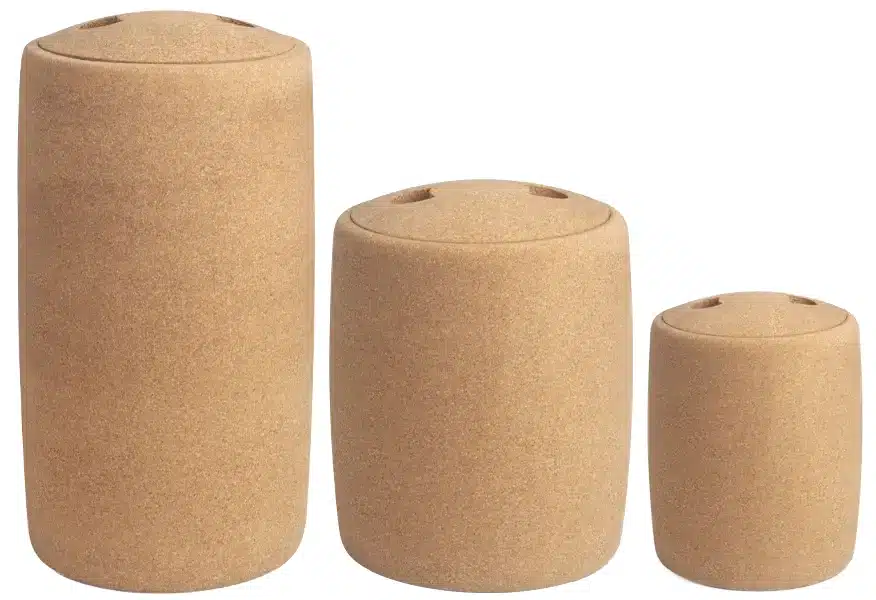Losing a loved one is a moment of immense sadness, and organizing the funeral is a crucial step in honoring their memory. At the heart of this process, the funeral urn plays a central role for those who choose cremation. Far more than a simple container, the urn becomes a tangible symbol of remembrance, a place of solace, and an expression of enduring love.
What is a Funeral Urn?
A funeral urn, or cremation urn, is a receptacle designed to hold the ashes of a person (or pet) after cremation. Its use dates back to antiquity, evolving through the ages to adapt to customs and family wishes. Today, urns are available in an incredible diversity of shapes, sizes, materials, and styles, allowing everyone to find the most fitting and personal tribute.
The Urn’s Role in the Grieving Process
The urn serves not only to contain ashes. It is a focal point for grief and commemoration:
- A Place of Remembrance: Whether placed in a columbarium, a garden of remembrance, at home, or in a symbolic location, the urn offers a physical space where loved ones can gather, reflect, and remember.
- A Symbol of Presence: For many families, having the urn nearby helps maintain a sense of the loved one’s presence, offering daily comfort.
- A Legacy Item: The urn can become an item of transmission, a precious keepsake passed down through generations, thus perpetuating family memory.
- A Personalized Choice: Choosing an urn is a deeply personal decision that reflects the deceased’s personality or the family’s preferences, allowing for a unique final tribute.
Choosing the Ideal Funeral Urn: Materials and Styles
The diversity of funeral urns is vast, offering options for all tastes and intentions:
- Traditional and Noble Materials:
- Ceramic and Porcelain: Offer a wide variety of shapes, colors, and finishes, often artistic.
- Marble and Granite: Robust and timeless, they convey an impression of solemnity and durability.
- Bronze and Metal: Durable and often very elegant, they can be engraved or adorned.
- Cork: : Brings a natural warmth and connection to the earth, often appreciated for its simplicity and authenticity.
- Ecological and Biodegradable Materials:
- Biodegradable urns (made of cork, salt, sand, recycled paper): Designed to dissolve and return to nature, they are ideal for scattering at sea, burial in the ground, or ecological burials.
- “Tree“ urn : A major innovation, these urns contain a sapling or a green plant that grows from the ashes, transforming the memory into a living tribute and a return to the cycle of life (like the TreeUrn).
- Styles and Personalization:
- From classic designs to modern and artistic forms.
- Possibility of personalized printing(names, dates, messages).
- Thematic options (nature, spirituality, the deceased’s hobbies).
Where to Place Funeral Urns: Options and Regulations
The destination of the ashes is an important decision, often governed by specific regulations that vary by country and sometimes even by region. It is essential to inquire with local authorities (city hall, prefecture) or funeral professionals to ensure your choice complies with regulations.
Here are common options, with a particular focus on biodegradable urns and tree urns:
- Columbarium: A public edifice with niches where urns are placed. This is a common solution in traditional cemeteries.
- Garden of Remembrance: A dedicated area within a cemetery where ashes can be scattered, often around a communal monument or memorial tree. Urns are generally not interred here.
- Columbarium Plot (Cavurne): A small underground funeral plot, often in open ground or with a small vault, specifically designed for urn burial in a cemetery.
- At Home: Keeping funeral urns at home is permitted in many countries. This offers an intimate and personal space for family remembrance. However, if the urn is intended for burial, specific burial regulations apply.
- Ash Scattering: Ashes can be scattered in nature (sea, mountains, forest), subject to strict rules. It is generally forbidden to scatter ashes in public places, rivers, or public gardens without authorization. Scattering at sea often requires a certain distance from the coastline.
- Burial of Biodegradable Urns (including Tree Urns):
- In a Private Garden: This is an increasingly popular option for biodegradable urns, including tree urns. In many countries, it is permitted to bury a biodegradable urn (containing human or animal ashes) on private property, such as a garden, as long as it is done discreetly and respectfully. It is generally not necessary to obtain special authorization for burial in a private garden, but it is always prudent to check local regulations for any specific restrictions (e.g., regarding groundwater).
- In Green or Natural Cemeteries: More and more cemeteries offer sections dedicated to ecological burials. These green cemeteries are specifically designed to accommodate biodegradable urns or bodies in biodegradable shrouds, in harmony with the environment. The tree urn naturally finds its place here, transforming the plot into a wooded, living site.
- In Nature (Burial): Unlike scattering, burying an urn in nature (outside urban areas and protected sites) is subject to very strict regulations and often prohibited without specific authorization. Principles of environmental respect and non-pollution of soil and water are paramount. Vigilance is essential, and it is imperative to obtain precise information.
The Funeral Urn: A Meaningful Choice
Choosing a funeral urn is an intimate step in the grieving process that allows for honoring a loved one’s life in a meaningful and lasting way. Whether classic or innovative, discreet or personalized, the urn offers families a means to maintain a connection with the deceased and find comfort in remembrance.


0 Comments